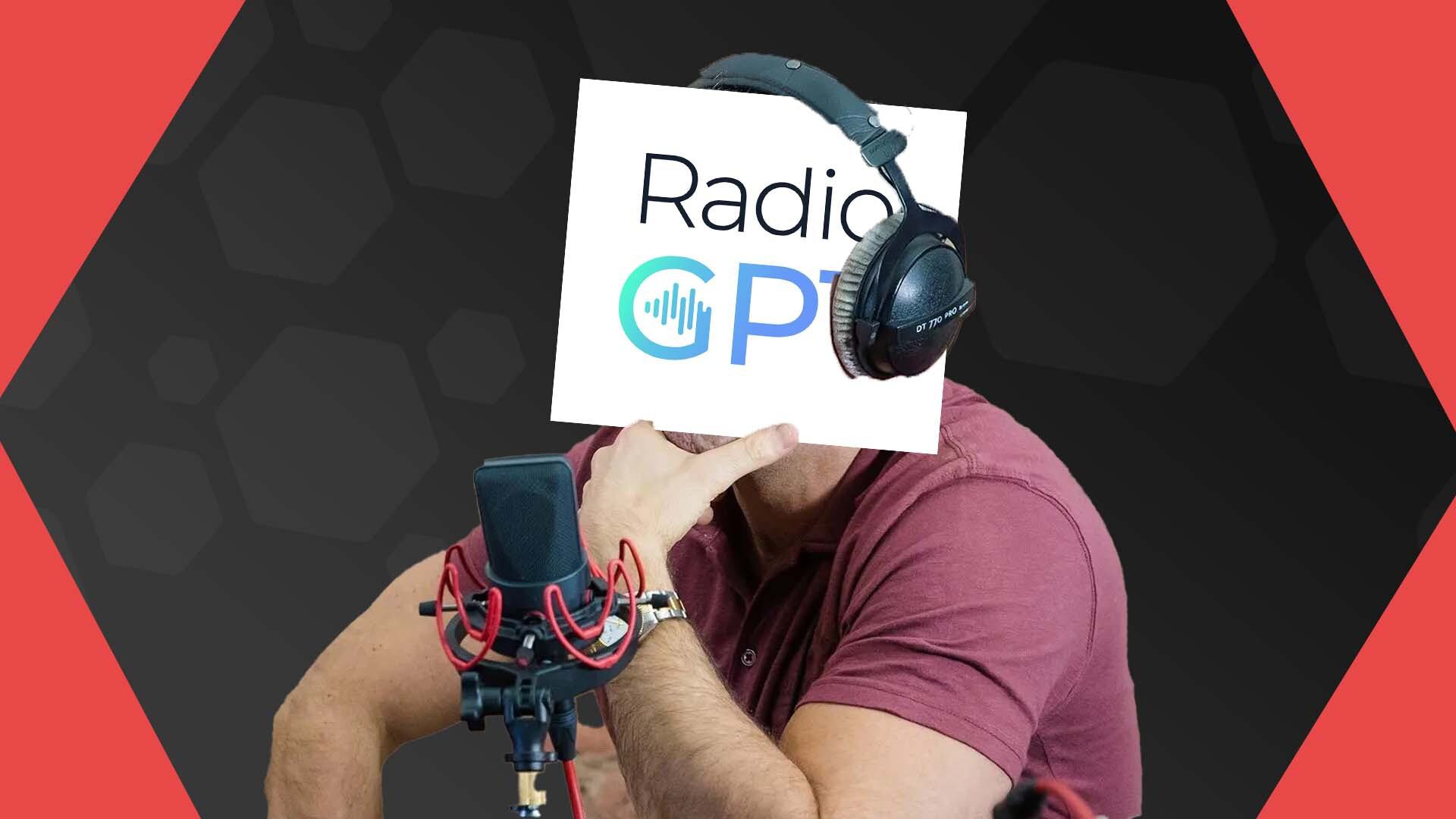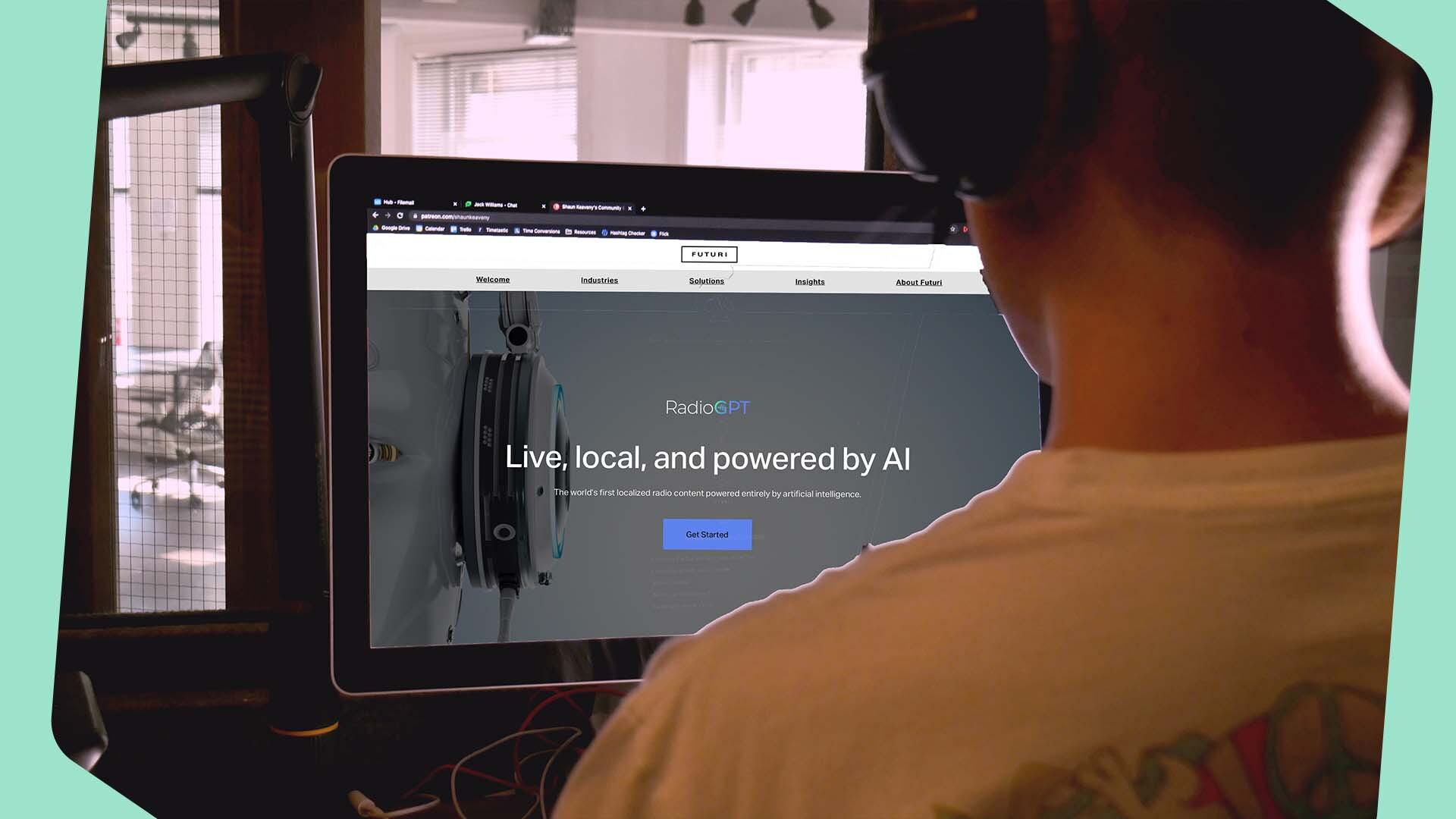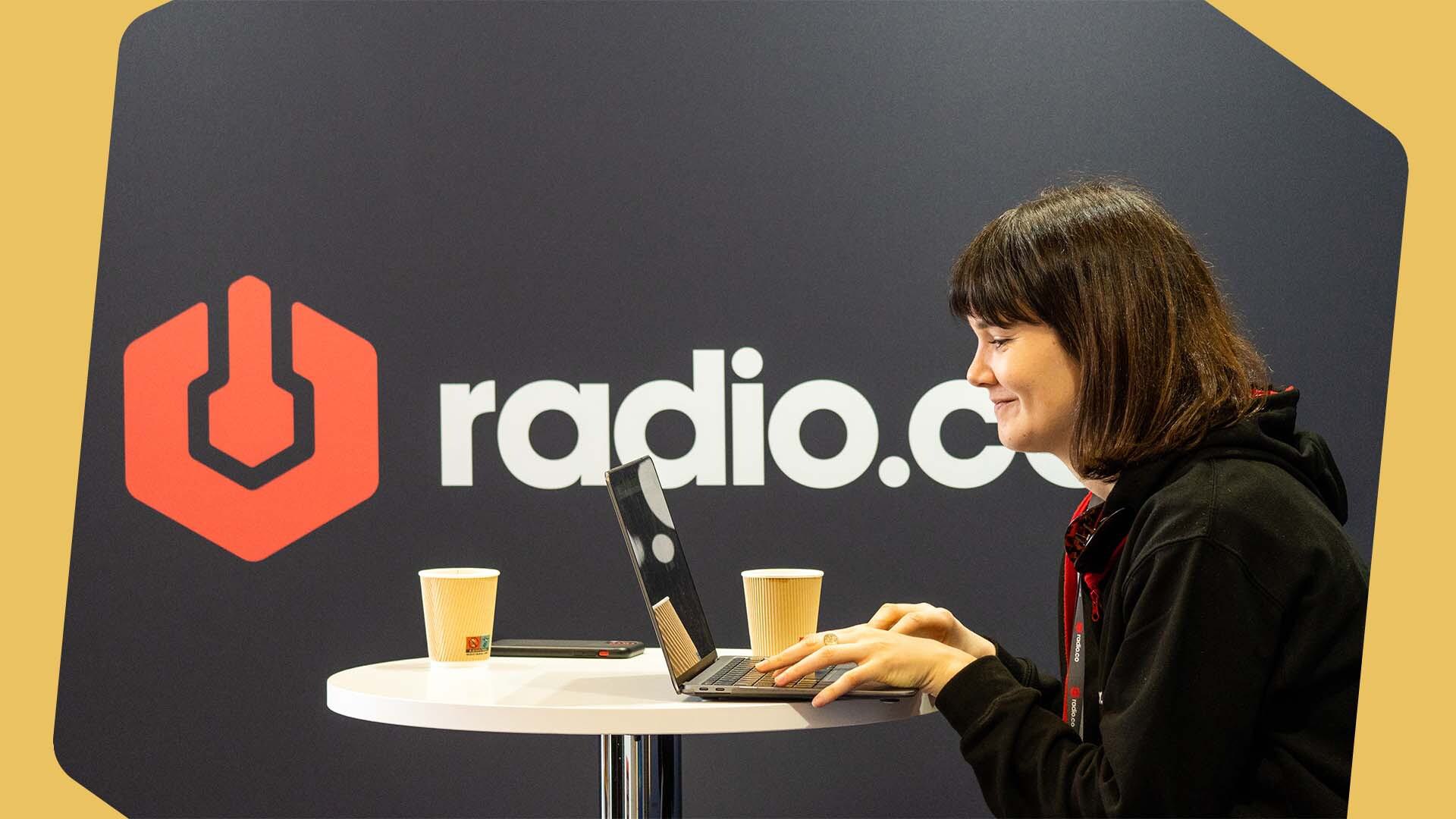Need advice? Let's talk.
Get straightforward guidance from your broadcasting partner. Schedule a call to chat with the team about your radio station.
Book DemoAI Voices for Radio Jingles: FREE Tools for Better Audio
Streamline your station's production without an army of DJs. Use AI voices for radio jingles, sweepers, and promos to save time and sound professional (whilst maintaining your authenticity).
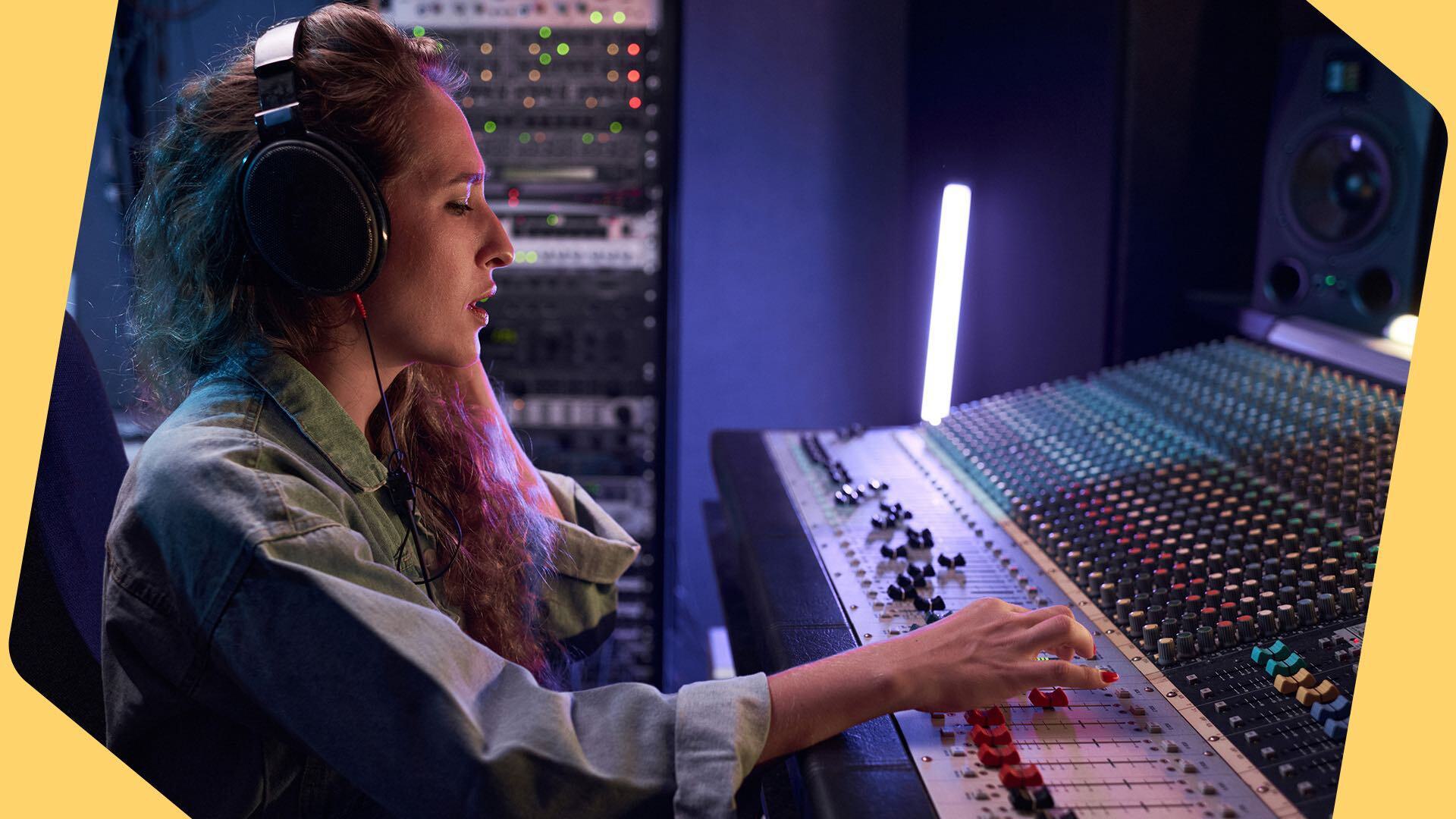
In a sea of static, your online station has one shot to make an impact.
Music? With over 10,000 internet stations, 1457 are probably slingin’ that same Steely Dan track right now. Music is no longer radio’s Most Valuable Product (MVP). Sure, it may initially hook a listener, but what happens between the tunes is your: Secret Ear Hole Sauce.
YES! I’m blowing hot air about your radio imaging: jingles, sweepers, liners, promos. The more they POP with originality, creativity and personality, the more ‘bookmark-y’ your station becomes. AI voices for radio jingles can streamline your production without an army of DJs (whilst staying authentic to your station's brand).
"Today's Hits, Yesterday's Favourites"?
Stiff. Predictable. Forgettable. The 80s faxed and they want their slogan back.
In a landscape dominated by cookie-cutter production, don't settle for swimming in the shallow end. The water's warm there for a reason! Instead, let's dive deep into AI voice innovation and create radio production that makes listeners lean in… not tune out.
Robo Radio?! I Don’t Think So
Before you print this page just to run it through the shredder while yelling, “More robo radio crap to ruin our industry? Hells no, RadioDJ Dork!”
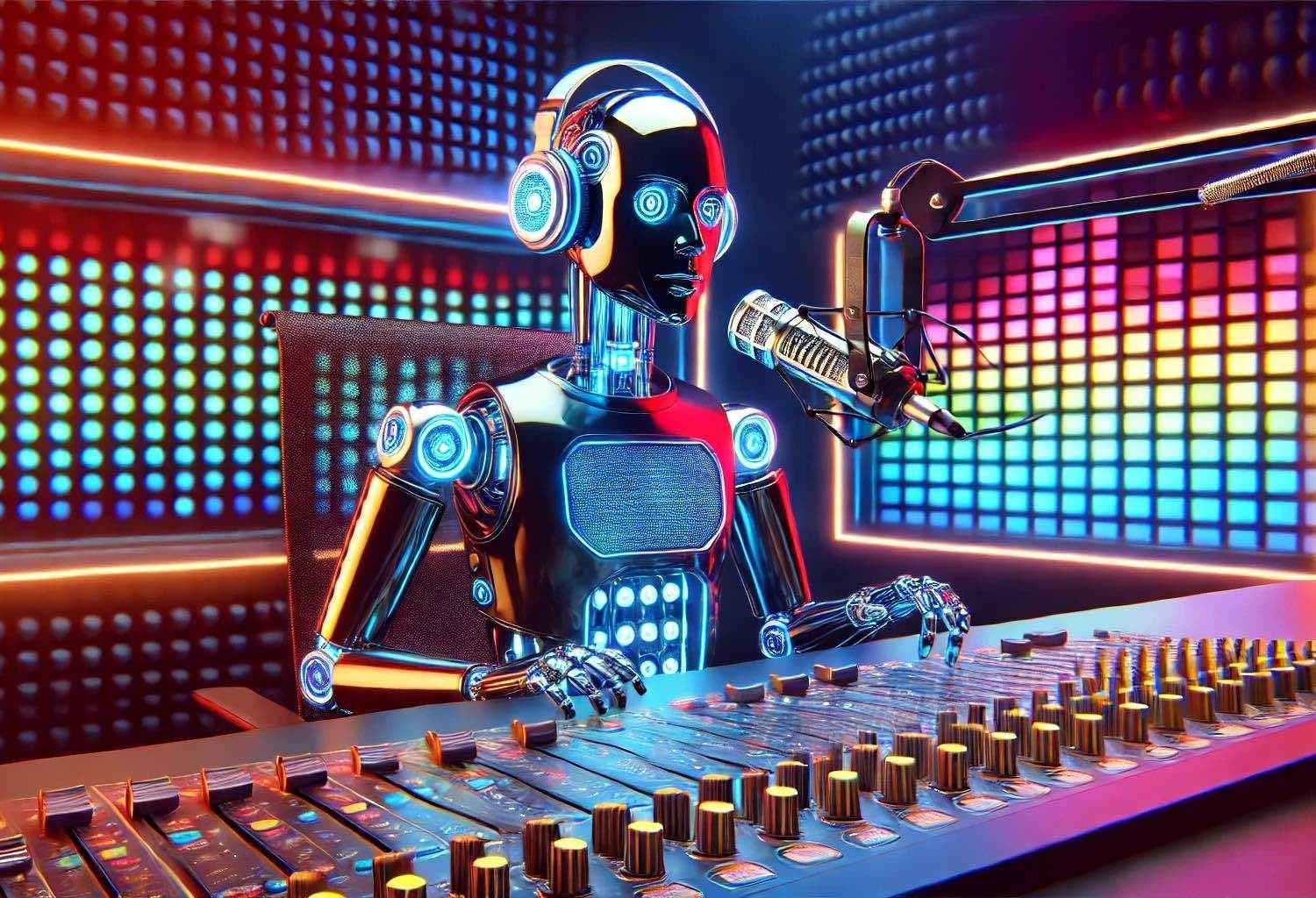
But hang on…
It’s not about creating robotic radio – it’s about infusing your production with the freedom to experiment, diversify, and create elements that would otherwise be financially or logistically impossible.
- Bam! Creative inspiration strikes. It’s 2AM. Who’s going to record your brilliant script?
- Damn! You just blew your VO budget last night on corn dogs and beer at the bowling alley.
In olden days, this would entail swiping a credit card, submitting a script, and waiting for the first cut. Often with lengthy re-edits.
“No, you need to hit ‘Rad 80s’ harder. Please redo.”
The timeline from idea to on-air execution was 3-5 days. With this tech, it’s now 3-5 minutes… and that includes making coffee.
BUT, I get it. AI and radio is dicey. I’m not suggesting replacing human word speakers (aka voice over talent). Coming up, I’ll even offer ideas to integrate the human with the bot (it’s my preferred technique). Just keep an open ear. Done right, a world of creative opportunities crack open.
The best part? With the right approach, you can achieve 85% believability – more than enough to sell the effect while keeping your production budget firmly in the "free-to-affordable" range.
Casting All Voice Bots: Choose Wisely
Not all AI voice generators are created equal. Junky, robotic voices will immediately signal to your listeners that you cheaped out and don’t care. In radio, all we have on offer is our sound. SO, if you can’t invest the time to find the most realistic voices possible, don’t bother. Robo voices are listener repellent. Your station and audience deserve better. Rant over.
ElevenLabs stands out as one of the premier services offering remarkably realistic voices. Their free tier gives you enough credits to experiment, while a paid subscription ($5/month) unlocks their full library of voices.
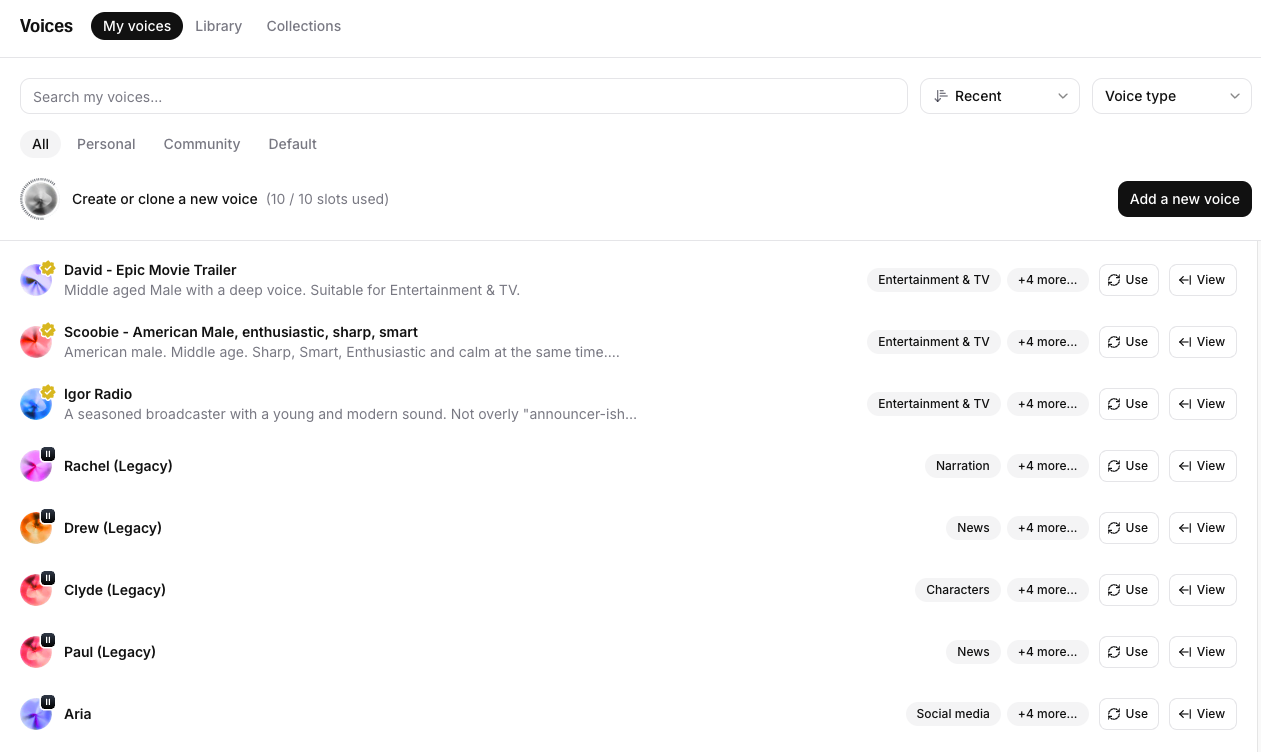
When selecting voices, prioritise two things:
- Authenticity: How real does the voice sound?
- Natural delivery: Does the read flow naturally or sound mechanical?
Don't settle for the first voice you try. Like app dating, you may get carpal tunnel from all the clicking/swiping.
Unlike human voice talent who can take direction, finding the right AI voices for radio jingles often means auditioning many options until you discover your station's perfect match. This usually happens just before your ears start to bleed.
Directing Your Robo Voice Talent
Here's where the magic happens! AI voices need direction just like human talent, but instead of verbal cues, you'll use text formatting, punctuation, and creative spelling.
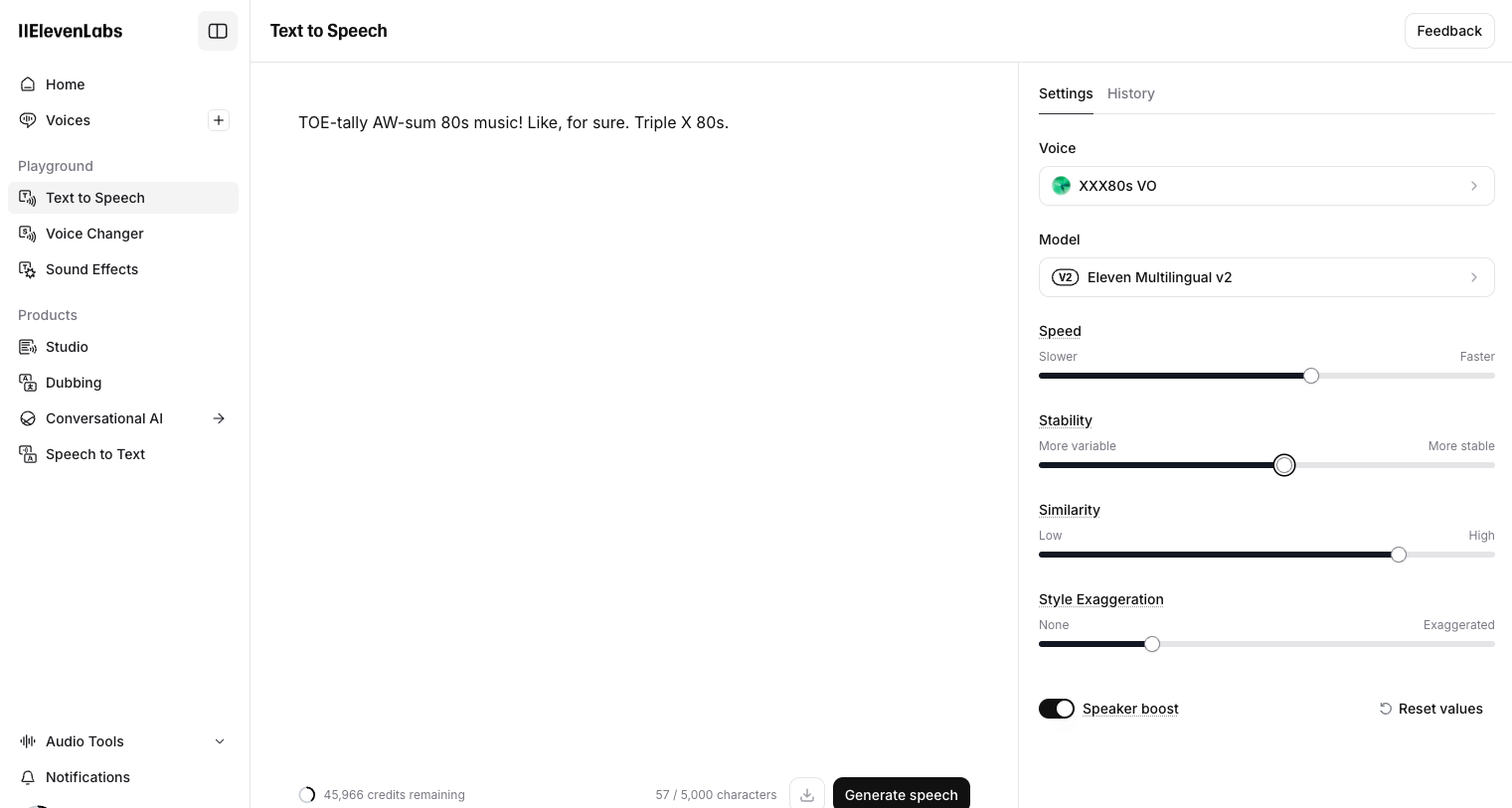
Consider this basic station slogan from my all 80s powerhouse, XXX80s.com:
Triple X 80s plays totally awesome 80s music.
Sounds flat and lifeless in most AI voices. Now try:
Triple X 80s... plays TOTALLY awesome 80s music!
Still not right? Try spelling phonetically (not needed for this liner, but you get the idea):
Triple X 80s...Plays TOETALLY AWEsum 80s music!
Or break it onto multiple lines to change inflection:
Triple X 80s,
Plays TOTALLY awesome 80s music.
Don’t forget about punctuation. Add a comma for a slight pause between words. For more predictability, use ElevenLabs’ <break time="x.xs" /> tag for pauses up to three seconds.
These aren't just random tweaks – they're you being the director, pulling everything possible out of your AI talent. Each AI voice responds differently to these techniques, so experiment liberally.
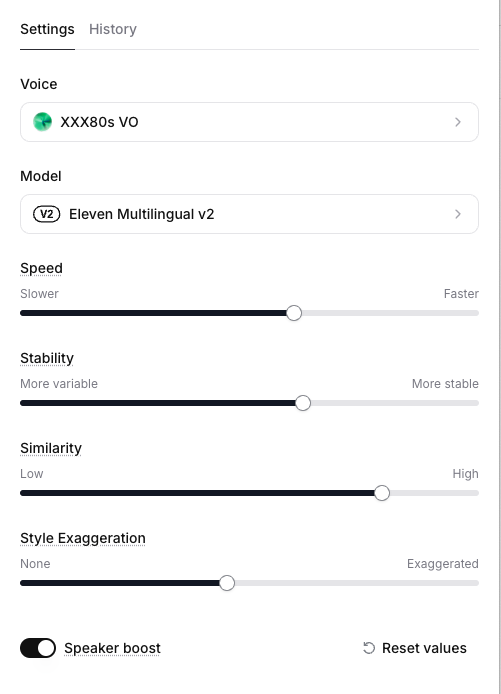
In ElevenLabs, many voices offer settings to tweak: speed, stability, similarity, and style exaggeration.
Warning: I hope you enjoy rabbits and holes. Modifying these settings and regenerating the voice cues can be a deep exploration. Even the slightest change can produce wild results. Patience, my robo voice jockeys. Keep tweaking until you dig the sound. Make sure to copy those settings for future sessions.
Other AI voice services, like Murf.ai, offer more control over emotions – cheerful, friendly, shouting, whispering – that dramatically alter delivery.
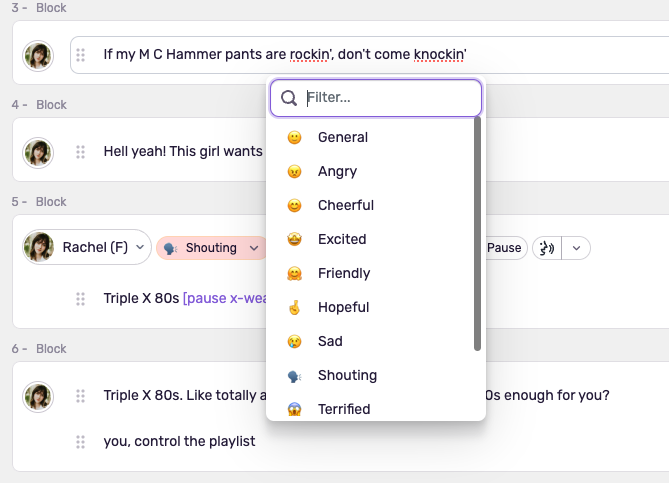
Plus, their "Emphasis" feature lets you fine-tune specific words by dropping keyframes in a special editor. Raising and lowering these points help create natural speech patterns that sell believability.
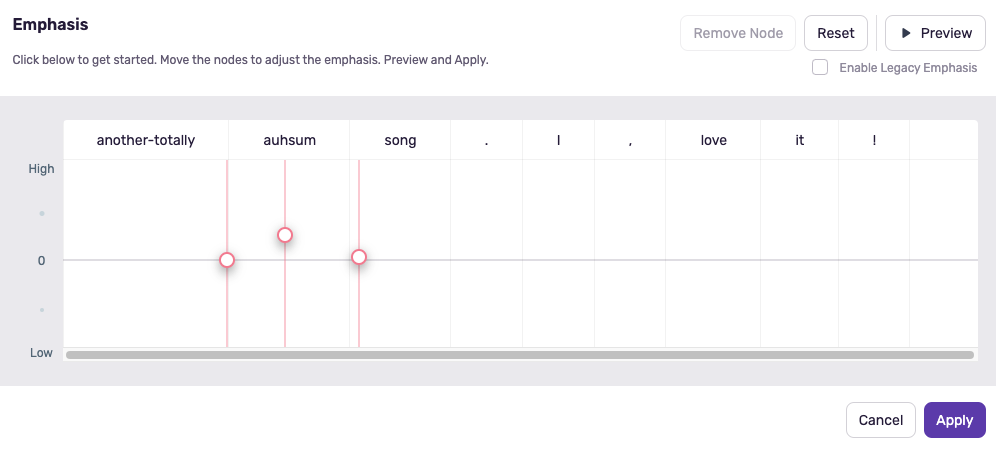
For example, emphasizing “awesome” (in "Another totally awesome song") creates that authentic rising inflection that humans naturally use when expressing excitement. The only thing better than reading about audio… is filling your ears with it. After you finish this article, I dare you to watch these tips in action on my RadioDJ Dude YouTube channel. I have a sack full o’ AI-related radio content. BUT, read on, you’ll never guess how this blog ends!
Robo Parrot: The Power of Speech-to-Speech
Text-to-speech is great, but it's like trying to explain colours to someone who can only see in black and white. Speech-to-speech takes AI voice generation to a whole new level. Instead of typing out your script with random capitalisation and punctuation, hoping to nail that perfect inflection, just say it how you want it. Record yourself reading the line with the exact tone, pacing, and emotion you want, then let the AI mimic your delivery.
AI cuts production time in half whilst sounding believable.
In ElevenLabs, this feature delivers more granular control over every aspect of the read. That slight pause before the punchline? That subtle emphasis on your call letters? That excited uptick at the end of your contest promo? All preserved in the AI version. This approach can cut your production time in half. No more generating 46 different takes just to get the right emphasis on "totally". Just one recording of you saying it right, and the AI will follow your lead with uncanny precision. Totally cool, right?
The AI Voice Processing Playbook
Here's the auditory truth: AI voices need different processing than human voices. That compressor setting that makes your morning show host sound like radio gold? It might turn your AI voice into distorted mush.
Create dedicated processing chains in your DAW specifically for AI voices. Here's a starting template:
- EQ: Apply a subtle high-pass filter around 120Hz (not 80Hz like human voices) to remove artificial low-end rumble that many AI voices generate.
- De-essing: AI voices often need more aggressive de-essing around 5-7kHz to tame digital sibilance.
- Compression: Use gentler ratios (2:1 versus 4:1) with slower attack times to preserve the natural attack of consonants that AI often struggles with.
- Saturation: A touch of analogue-style saturation (2-5%) adds harmonics that make AI voices sound less digital and more organic.
- Reverb: Apply slightly more reverb than you would for human voices, but keep it subtle – just enough to place the voice in a real acoustic space.
The processing differences are subtle but crucial. When listeners can't quite put their finger on why your AI voices sound so much more natural than your competitors', you'll know it's because you took the time to craft the perfect processing chain.
- Bonus tip: Some AI voices need more life - (Ha! See what I did there?). A life-infusing technique is to increase the tempo by 2-5%. This change adds pep to the read which is key to keeping the momentum chuggin’ forward.
- Even more bonus-y tip: Many AI voice models insert unnatural bits of silence into the “recordings”. This slams the breaks on momentum and believability. Make sure to trim the silence for a more natural sound.
To expedite the production process, I created an Adobe Audition template and some Audacity macros that are fine-tuned for processing AI voice overs. One click transforms robo sound from blah to broadcast-ready. Less time spent on wrangling voice settings can be invested in actually producing the jingle/sweeper.
Production Elements Perfect for AI Voices
Let creativity be your muse. AI voices excel in numerous radio imaging applications.
Listener Testimonial Montages
Nothing builds credibility like hearing "real people" talking about your radio station.
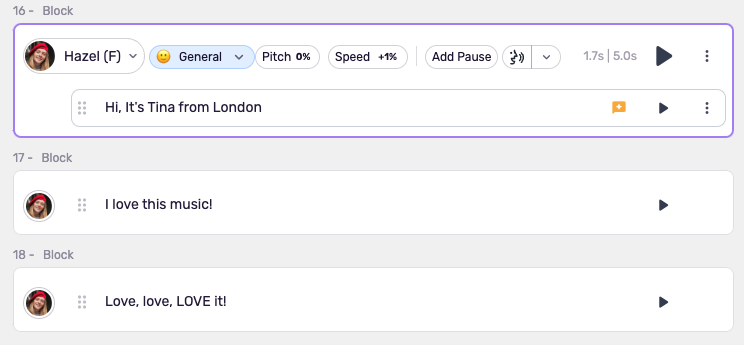
Create a global listener montage of text-to-speech quotes using AI.
- Female 1: "I'm Julie from New York"
- Male 1: "It's Mike from San Diego"
- Female 2: "Hi, it's Tina from London"
- Female 1: "The 80s are my jam!"
- Male 1: "I love this music"
- Female 1: "My favorite station"
- Female 2: "Love love LOVE it!"
Mix multiple AI voices with varying accents to create a worldwide fan base for your station – all without leaving your production studio.
Whisper Jingles
Use a whisper-themed AI voice to create simple, short production elements. With some light sound design, these can pack a punch.
[Whispered] Totally awesome radquests. Triple X 80s dot com.
A "whispering" tone embodies an intimate, ASMR-like quality ideal for contrast between high energy music elements. Nothing wakes a listener from a pre-drool haze like contrast! Loud to soft, back to loud, is a solid pattern interrupt.
General Station Imaging
Create unique positioning statements that slice through the noise:
Triple X 80s. Rocking your mullet with totally awesome 80s!
Where we’re going, we don’t need roads… just parachute pants. Triple X 80s!
Since the barrier from idea to VO file has been obliterated, experiment with as many fun slogans you can muster (if “mustering” is still legal in your county). If you run a decade-based station, go nuts with incorporating movie, TV, and other decade-specific pop culture references in your imaging.
Feature Opens
Liberation day… today! This has been quite freeing for me. When I’m cookin’ up nutty ideas for on-air features, like 'Fun Artist Facts', 'The Decade Double Play' or 'Totally Rad Rewind', produced openers help sell the bit and add a ton o’ production value. The speed of transforming an idea to an air ready element is jaw-dropping.
Advanced Production Techniques
AI is fickle. Without your input, it'll wander off the garden path (and get firmly wedged behind the shed). But you don't need to lean 100% into AI. That's not the point of AI voices for radio jingles, sweepers, and everything else radio imaging related for better audio. The idea is to weave the AI and human elements together.
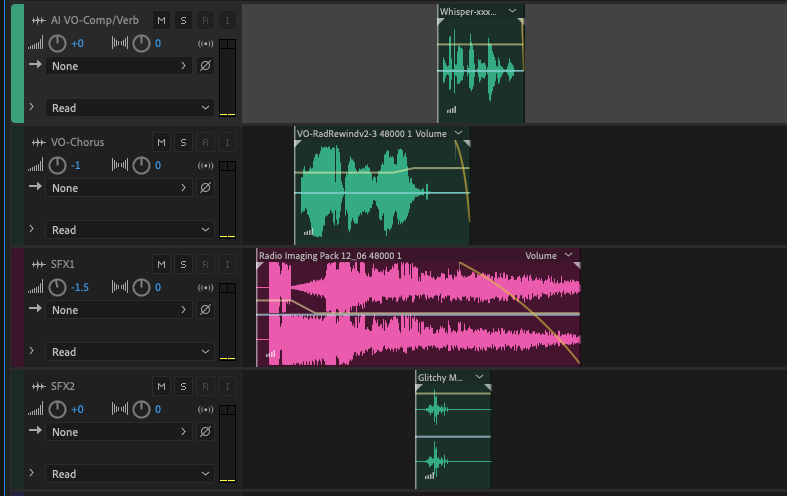
The Human Hack
A key trick for selling AI voices? Include at least one real human voice element. Example:
- Human voice: "Triple X 80s"
- AI voice: "Rocking your mullet with totally awesome 80s!"
Due to the proximity effect, that one authentic element helps listeners accept the AI portions as real.
Mix and Match
Don't like the way an AI voice says certain words? Generate multiple takes and pick the best.
- Cue: “We don’t need roads where we’re going… just parachute pants. Triple X 80s.”
After running this 12 times, you may like different parts from different takes.
- Take 3: “We don’t need roads where we’re going”
- Take 5: “Just parachute pants”
- Take 10: “Triple X 80s”
This technique creates more dynamic, interesting production elements. Plus, there’s more flexibility on not having to rely on just one solid take.
Sound Effects Matter
The right sound effects elevate your AI voice production. Use bold, attention-grabbing effects to introduce voiceovers, then subtler effects underneath to maintain energy.
ElevenLabs' AI sound effect generator offers unique, custom effects that no other station will have. Be selective – not every generated effect works, but the standout elements can make your production truly unique. Since we’re pumping production value, not draining wallets, search "Music for Radio", “Free Royalty Free Radio Sound Effects”, and “Free Radio Imaging Sound Effects” to start filling your basket with tasty audio nuggets.
Putting it All Together
While today's broadcasters often use "jingle" as a catch-all term, traditional radio makes important distinctions: Jingles are standalone production elements that play between songs and are usually sung. Sweepers run over the intro of songs.
For effective jingles, follow this simple formula:
- Bold attention-grabbing sound effect (1 second).
- Station name voiceover.
- Second sound effect (transitions to slogan).
- Slogan voiceover.
- Final punctuating sound effect with reverb tail.
For sweepers, modify your jingle elements to work over song intros:
- Use different opening sound effects.
- Add stutter effects on hard consonants (R-R-R-Rocking your mullet!).
- Add echo effects on final words (80s-80s-80s).
- Set proper "hit points" with sound effects that align with song intros.
Break the Mold, be Bold
Standing out in radio isn't about being louder – it's about being different. Ditch the generic. Closet the cliche. Challenge yourself to rethink every production element from a fresh perspective.
Variety keeps your favourites fresh, for longer.
That's as fresh as granny’s freeze dried fruit loaf from 1986. But remember: if your imaging doesn't perk ears and trigger smiles, you're just part of the noise.
The Future Sounds AI-mazing
The most valuable currency in modern radio is originality and authenticity.
AI voices aren't about faking it – they're tools that let you express your station's ‘authentic self’ in more creative and affordable ways. Use them to build imaging that connects with your audience. Create production elements that reflect your station's unique personality rather than sounding like every other stale station on the digital dial.

Flipping an idea from your head to the airwaves has never been faster or cheaper. These are historic times! AI voices can give your radio station the creative assist it needs to slice through the noise and offer a fresh alternative to the voice/soul-less “jukebox” formats.
Fire up those AI voice generators, experiment boldly, and transform your sound. Your listeners (and budget) will thank you. Now go create something robotastic!
Guest Author: Jeff "Radio DJ Dude" Scott
Jeff Scott, The RadioDJ Dude, is a major market radio pro and Emmy-winning TV producer who’s on a mission to “Make Radio Great Again”. For all things radio, check out his RadioDJ Dude YouTube channel. For cool/affordable templates and radio content ideas, please visit his shop. Most important: Keep rockin’ those mics all over the world!

(Disclaimer: Some links are affiliate links. By clicking the links you aren’t charged, but I receive a small commission. Plus, I only recommend products/services I use.)

